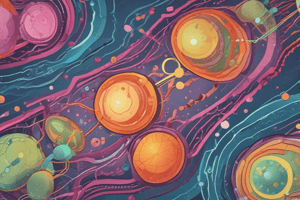Podcast
Questions and Answers
What is the first step during the elongation of the polypeptide chain?
What is the first step during the elongation of the polypeptide chain?
- Energy expenditure
- Translocation
- Peptide bond formation
- Codon recognition (correct)
Which type of protein is involved in the addition of amino acids to the growing polypeptide chain?
Which type of protein is involved in the addition of amino acids to the growing polypeptide chain?
- Elongation factors (correct)
- Transfer RNA
- Ribosomal RNA
- Release factors
What causes the addition of a water molecule instead of an amino acid during translation termination?
What causes the addition of a water molecule instead of an amino acid during translation termination?
- Release factor (correct)
- Ribosome
- Transfer RNA
- Elongation factor
Where does a stop codon need to reach for termination to occur during translation?
Where does a stop codon need to reach for termination to occur during translation?
Which energy-consuming step occurs during both translation initiation and elongation of the polypeptide chain?
Which energy-consuming step occurs during both translation initiation and elongation of the polypeptide chain?
What causes the release of the polypeptide and the disassembly of the translation assembly during termination?
What causes the release of the polypeptide and the disassembly of the translation assembly during termination?
Which component brings together mRNA, tRNA, the first amino acid, and the two ribosomal subunits during translation initiation?
Which component brings together mRNA, tRNA, the first amino acid, and the two ribosomal subunits during translation initiation?
What is the role of the small ribosomal subunit during translation initiation?
What is the role of the small ribosomal subunit during translation initiation?
Which site of the large ribosomal subunit contains the catalytic site for forming bonds between amino acids?
Which site of the large ribosomal subunit contains the catalytic site for forming bonds between amino acids?
What is the function of aminoacyl-tRNA synthetase in protein synthesis?
What is the function of aminoacyl-tRNA synthetase in protein synthesis?
During which stage of translation does a small ribosomal subunit bind with mRNA and a special initiator tRNA?
During which stage of translation does a small ribosomal subunit bind with mRNA and a special initiator tRNA?
What is the primary function of the small ribosomal subunit in translation initiation?
What is the primary function of the small ribosomal subunit in translation initiation?
What is the consequence of a nonsense mutation?
What is the consequence of a nonsense mutation?
Which type of mutation is Mutant 1 (AUGUCUUAUGUGGGGUAA)?
Which type of mutation is Mutant 1 (AUGUCUUAUGUGGGGUAA)?
What is the effect of a silent mutation on the protein product?
What is the effect of a silent mutation on the protein product?
How does a frameshift mutation differ from a base substitution?
How does a frameshift mutation differ from a base substitution?
What is the impact of a gain-of-function mutation on protein activity?
What is the impact of a gain-of-function mutation on protein activity?
How do missense mutations differ from nonsense mutations?
How do missense mutations differ from nonsense mutations?
Flashcards
Codon Recognition
Codon Recognition
The process where the ribosome recognizes the start codon (AUG) on mRNA and initiates polypeptide chain synthesis.
Elongation factors
Elongation factors
Proteins that facilitate the addition of amino acids to the growing polypeptide chain during translation.
Release factor
Release factor
A protein that binds to a stop codon in mRNA during translation, causing the release of the polypeptide chain and the disassembly of the ribosome.
A site
A site
Signup and view all the flashcards
Translocation
Translocation
Signup and view all the flashcards
Release factor action
Release factor action
Signup and view all the flashcards
Initiation factors
Initiation factors
Signup and view all the flashcards
Small ribosomal subunit
Small ribosomal subunit
Signup and view all the flashcards
P site
P site
Signup and view all the flashcards
Aminoacyl-tRNA synthetase
Aminoacyl-tRNA synthetase
Signup and view all the flashcards
Initiation
Initiation
Signup and view all the flashcards
Small ribosomal subunit function
Small ribosomal subunit function
Signup and view all the flashcards
Nonsense mutation
Nonsense mutation
Signup and view all the flashcards
Missense mutation
Missense mutation
Signup and view all the flashcards
Silent mutation
Silent mutation
Signup and view all the flashcards
Frameshift mutation
Frameshift mutation
Signup and view all the flashcards
Gain-of-function mutation
Gain-of-function mutation
Signup and view all the flashcards
Missense mutations
Missense mutations
Signup and view all the flashcards



